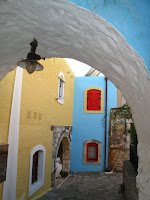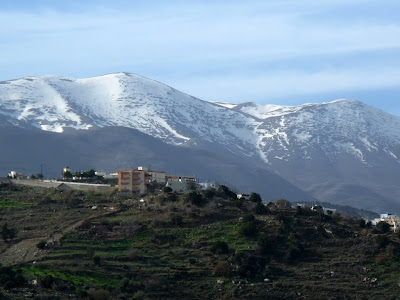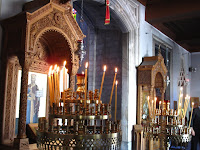 The New Year started with a very windy, although warm and sunny day. We set out to explore the central area of Crete behind Heraklion, up into the foothills of Mount Ida.
The New Year started with a very windy, although warm and sunny day. We set out to explore the central area of Crete behind Heraklion, up into the foothills of Mount Ida.Our first stop was Arolithos, which is a purpose built 'traditional village'.
 It is privately owned, and really delightful. In the busy season, it would be very interesting as all the old crafts are on show for the tourists.
It is privately owned, and really delightful. In the busy season, it would be very interesting as all the old crafts are on show for the tourists.The road climbed higher to the village of Tilisos. Here a modern village is built right beside an ancient Minoan town. Unfortunately the archaeological site was closed for New Year's Day, but we were able to see part of it beside the road.
 After Tilisos, the road started climbing in earnest, and unfortunately, the wind picked up considerably, so by the time we reached the interesting village of Anogia, it felt like gale force, and was most unpleasant. As a result, we only toured the village by car.
After Tilisos, the road started climbing in earnest, and unfortunately, the wind picked up considerably, so by the time we reached the interesting village of Anogia, it felt like gale force, and was most unpleasant. As a result, we only toured the village by car.  The villagers have a reputation for toughness, they certainly would need to be tough to endure the winters, so close to snow covered Mount Ida. They have had a very sad history, being the target of various invaders, most recently in 1944 the Germans shot every male in the village and burnt every house to the ground in retaliation for their part in the capture of the German General in charge of Crete.
The villagers have a reputation for toughness, they certainly would need to be tough to endure the winters, so close to snow covered Mount Ida. They have had a very sad history, being the target of various invaders, most recently in 1944 the Germans shot every male in the village and burnt every house to the ground in retaliation for their part in the capture of the German General in charge of Crete.
 We had planned to drive up the mountain, as the road goes another 21k to the Idaean Cave, but the wind made it far from pleasant, such a contrast to the previous days.
We had planned to drive up the mountain, as the road goes another 21k to the Idaean Cave, but the wind made it far from pleasant, such a contrast to the previous days.









































